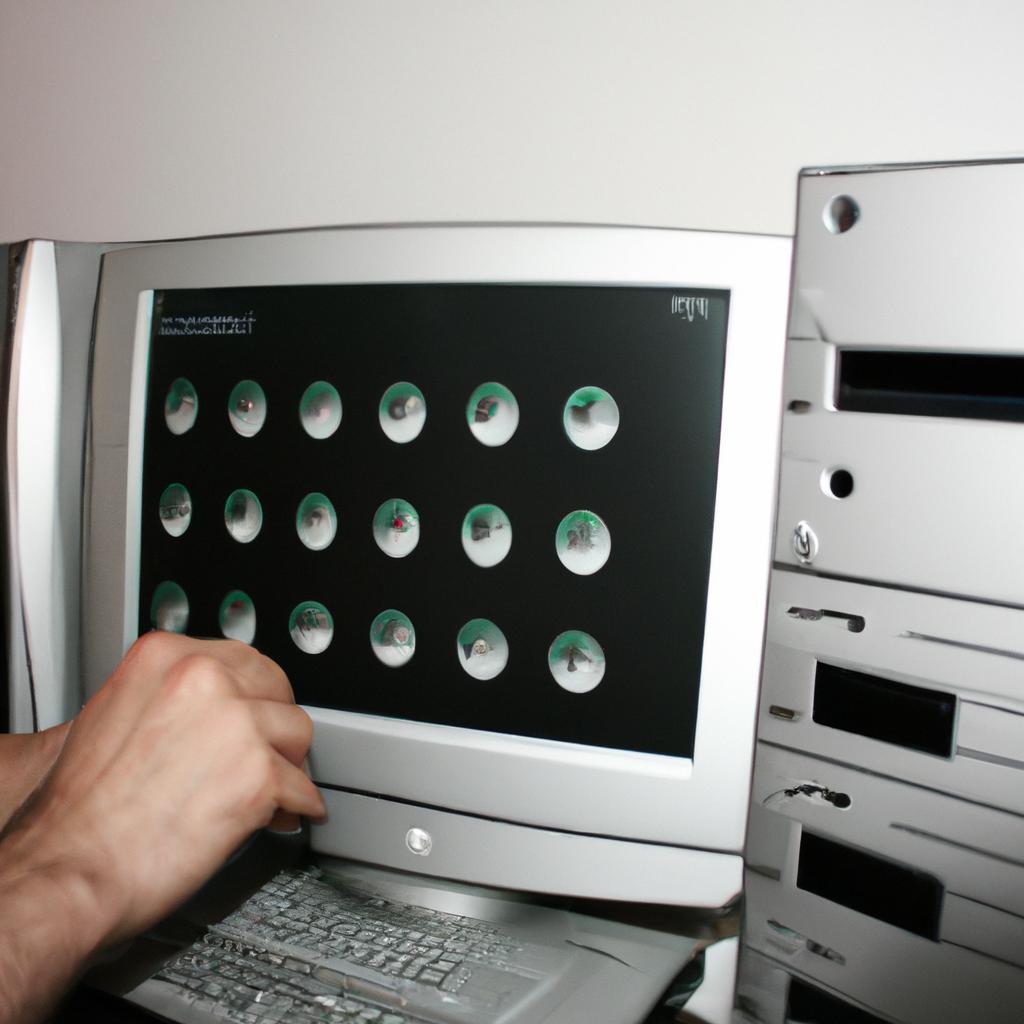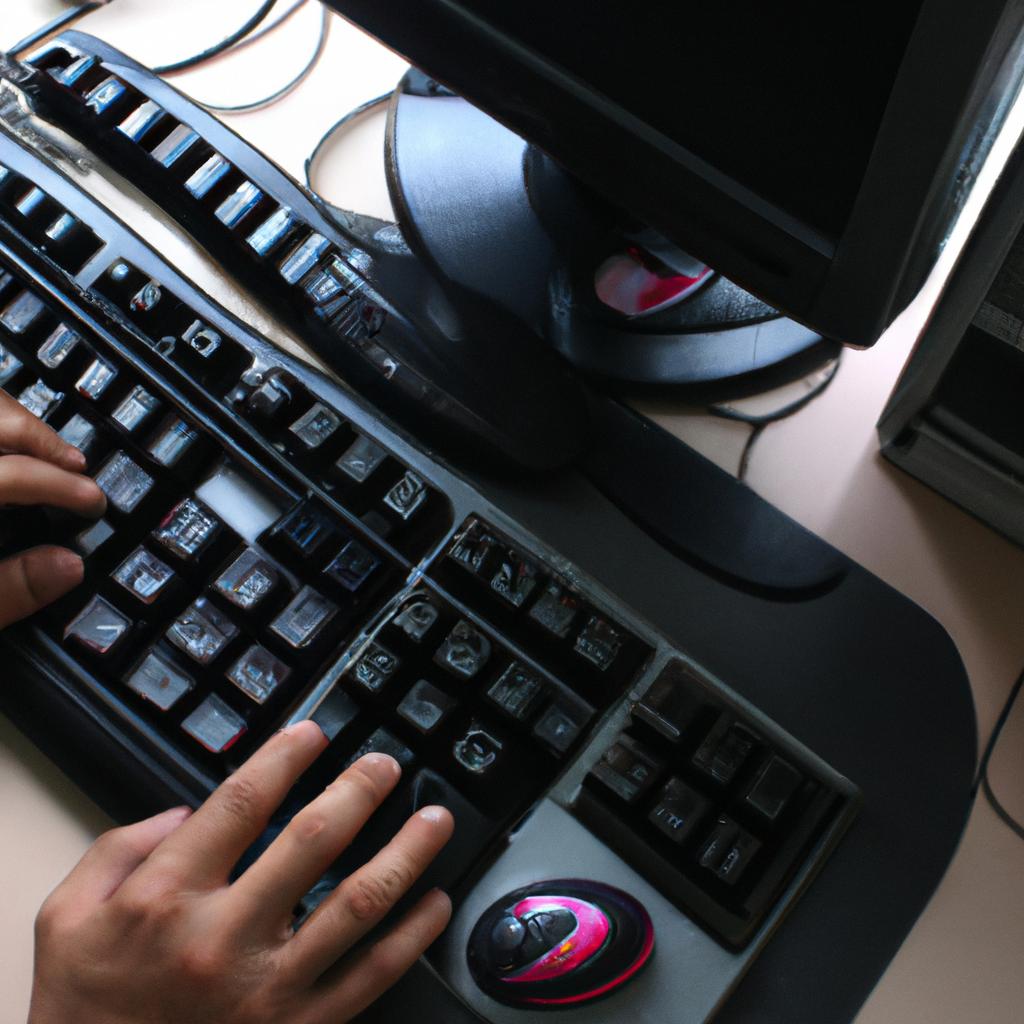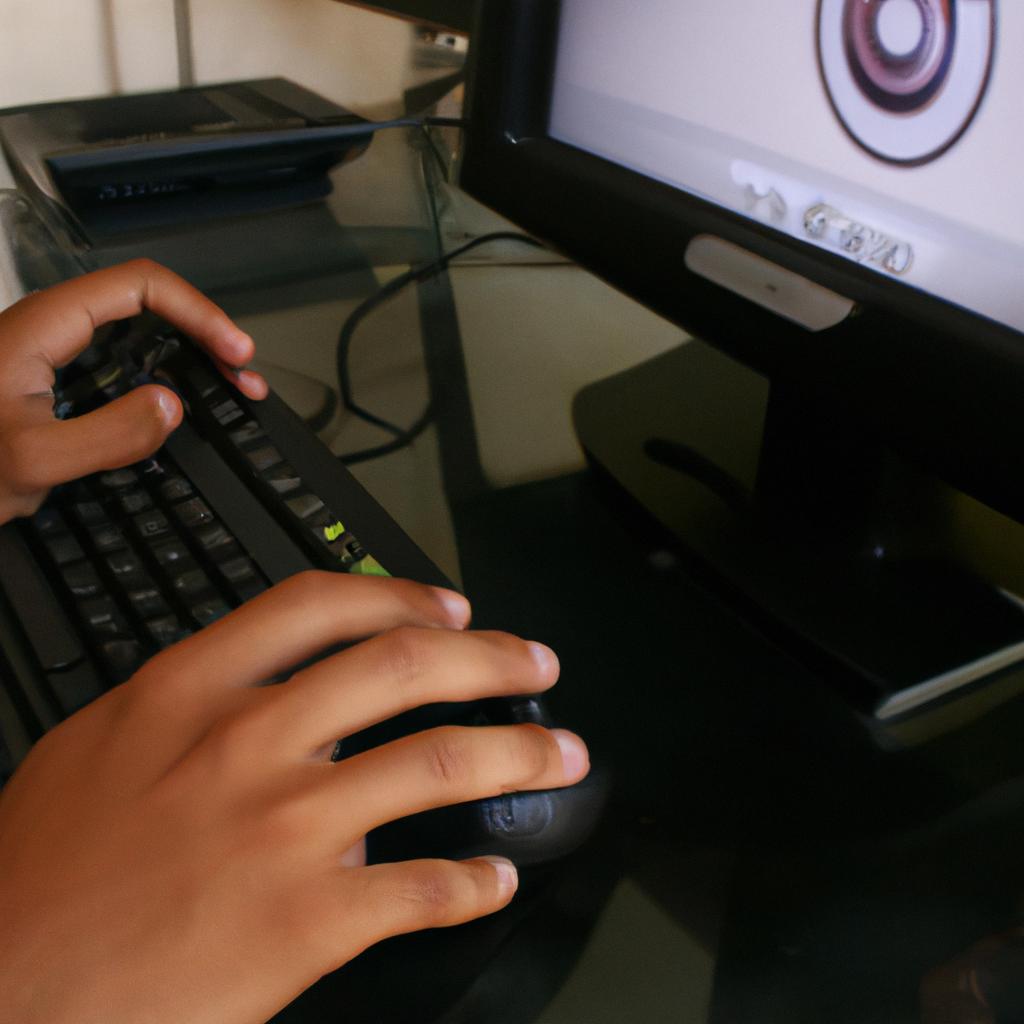Dolphin Compatibility: Emulators in Computer Systems
The increasing demand for compatibility between different computer systems has led to the development of emulators, such as Dolphin emulator, which allows users to run software and games from one system on another. This article explores the concept of dolphin compatibility and its implications in computer systems. To illustrate this concept, we will consider a hypothetical case study where a user wants to play a Nintendo GameCube game on their PC.
In our hypothetical scenario, the individual desires to relive their childhood memories by playing an old Nintendo GameCube game that they no longer have access to the original console for. However, they discover that the game is not compatible with their current PC operating system. In such cases, emulators like Dolphin come into play by allowing users to recreate the environment of the original console within their personal computer system. By running the game through an emulator designed specifically for this purpose, individuals can experience nostalgic gameplay without needing physical access to the original hardware or software.
The Importance of Dolphin Emulators
Imagine a scenario where you have an extensive collection of GameCube and Wii games, but your gaming console has become outdated or is no longer functional. You still yearn to play those classic titles that hold nostalgic value for you. This is where Dolphin emulators come into the picture, offering an innovative solution to play these games on modern computer systems.
One significant aspect highlighting the importance of Dolphin emulators is their ability to provide backward compatibility. With this software tool, users can run GameCube and Wii games seamlessly on their computers, opening up a world of possibilities for game enthusiasts who wish to relive their favorite childhood memories. By bridging the gap between old consoles and new hardware, Dolphin emulators ensure that cherished games are not left behind in the rapidly evolving gaming landscape.
To emphasize further why Dolphin emulators hold such significance, consider the following bullet points:
- Enables access to a vast library of GameCube and Wii games.
- Provides enhanced graphics and performance compared to original consoles.
- Offers customization options for improved gameplay experience.
- Facilitates community-driven enhancements through mods and hacks.
These factors contribute to creating an emotional connection with gamers by reviving beloved classics while enhancing them with modern technology.
Additionally, let us explore a table showcasing some key features provided by Dolphin emulators:
| Feature | Description | Benefit |
|---|---|---|
| Backward Compatibility | Play GameCube and Wii games on modern systems | Access to legacy titles |
| High Definition Rendering | Enhance graphics quality | Improved visual experience |
| Save State Functionality | Easily save progress at any point | Convenient gameplay management |
| Customization Options | Modify settings for personalized experience | Tailor gameplay according to individual needs |
Through this table, we can observe how Dolphin emulators offer various features that make them indispensable tools for gaming enthusiasts seeking to explore their favorite titles with enhanced performance and customization options.
In transitioning to the subsequent section about “Understanding Dolphin Emulator Architecture,” it is important to recognize how Dolphin emulators have revolutionized the way we experience these classic games. By delving into the intricacies of its architecture, users can gain a deeper understanding of how this software functions, enabling them to optimize their gaming experiences even further.
Understanding Dolphin Emulator Architecture
Dolphin Emulator Compatibility: A Crucial Aspect of Computer Systems
Imagine a scenario where you have recently purchased a high-end gaming computer, eager to relive your favorite childhood games. As you eagerly install the latest version of Dolphin emulator, an application that allows users to play Nintendo GameCube and Wii games on their computers, you are hit with disappointment when none of the games run smoothly or even load at all. This unfortunate situation emphasizes the importance of dolphin emulator compatibility within computer systems.
Compatibility is vital for any software application, including emulators like Dolphin. It determines whether an emulator can effectively mimic the behavior of a console system and execute games without major issues. When considering dolphin emulator compatibility in computer systems, several key factors come into play:
-
Hardware Specifications: The performance of an emulator heavily relies on the specifications of the host machine running it. Factors such as CPU speed, GPU capabilities, available memory (RAM), and storage space directly impact how well Dolphin can emulate games.
-
Operating System Support: Different operating systems may provide varying levels of compatibility with Dolphin emulator. While Dolphin supports Windows, macOS, and Linux platforms, certain features or optimizations might be limited on specific operating systems.
-
Peripheral Device Integration: Emulating console hardware often requires interaction with peripherals such as game controllers or motion-sensing devices. Ensuring proper integration between these peripherals and Dolphin contributes to effective gameplay experience.
-
Software Updates: Developers regularly release updates to enhance compatibility by addressing bugs and improving overall performance. Staying up-to-date with the latest version ensures maximum compatibility with various game titles.
To illustrate this further, consider the following table showcasing different scenarios based on hardware configurations:
| Hardware Configuration | Resulting Compatibility |
|---|---|
| High-end Gaming PC | Excellent |
| Mid-range Laptop | Good |
| Low-end Desktop | Limited |
This simple comparison demonstrates how hardware specifications can directly impact the compatibility of Dolphin emulator. It is crucial for users to consider their computer’s capabilities when planning to use Dolphin.
In summary, dolphin emulator compatibility plays a pivotal role in determining the performance and user experience within computer systems. Factors such as hardware specifications, operating system support, peripheral device integration, and software updates significantly influence how well Dolphin emulates console games. Next, we will delve into key factors that affect the overall performance of Dolphin emulator.
Transitioning into the subsequent section about “Key Factors for Dolphin Emulator Performance,” understanding these compatibility aspects sets the stage for optimizing emulation performance without compromising on gameplay quality.
Key Factors for Dolphin Emulator Performance
Understanding how emulators function and their compatibility with computer systems is crucial for optimizing performance. In this section, we will delve into the topic of Dolphin emulator compatibility and explore key factors that influence its effectiveness.
To illustrate the importance of compatibility, let’s consider a hypothetical scenario where a user wants to play a GameCube game on their Windows-based computer using the Dolphin emulator. However, upon launching the emulator, they encounter various issues such as lag, graphical glitches, or even crashes. These problems can often be attributed to hardware or software incompatibilities between the system and the emulator.
When it comes to achieving optimal Dolphin emulator performance, several factors need careful consideration:
- System Requirements: Ensuring that your computer meets the minimum system requirements outlined by the developers of Dolphin is essential. This includes having an adequate processor (CPU), sufficient RAM, and a capable graphics card (GPU) to handle rendering tasks effectively.
- Operating System Compatibility: Different operating systems may have varying levels of support for emulation software like Dolphin. It is important to choose an operating system that is known for its stability and has good community support from both developers and users.
- Driver Support: Keeping device drivers up-to-date plays a vital role in ensuring smooth gameplay while using emulators. Outdated or incompatible drivers can significantly impact performance and cause various issues.
- Peripheral Device Integration: The ability of an emulator to seamlessly integrate with peripheral devices such as controllers or adapters greatly enhances the gaming experience. Compatibility with popular input devices should be considered when choosing an emulator.
Emulator compatibility relies heavily on these factors working harmoniously together. By carefully evaluating each aspect mentioned above, users can increase their chances of experiencing smoother gameplay without encountering significant issues.
Transitioning into our next section about “Achieving Optimal Dolphin Emulator Settings,” understanding relevant aspects regarding compatibility sets us on the right path towards maximizing overall performance and enhancing our gaming experience.
Achieving Optimal Dolphin Emulator Settings
Achieving Optimal Dolphin Emulator Performance
To illustrate the importance of achieving optimal settings for the Dolphin emulator, let us consider a hypothetical scenario. Imagine a gaming enthusiast who wishes to play their favorite Nintendo GameCube and Wii games on their computer system using the Dolphin emulator. However, upon launching the emulator, they experience choppy gameplay and frequent frame rate drops, significantly detracting from their overall gaming experience. In order to overcome these challenges and ensure smooth emulation performance, it is crucial to understand key factors that contribute to Dolphin emulator performance.
There are several important considerations when striving for optimal Dolphin emulator performance:
-
Hardware requirements: The specifications of your computer system play a significant role in determining how well the Dolphin emulator will run. To achieve satisfactory performance, it is recommended to have a modern processor with multiple cores, ample RAM (at least 4GB), and a dedicated graphics card capable of handling demanding graphical tasks.
-
Graphics settings: Configuring appropriate graphics settings within the Dolphin emulator can greatly impact its performance. Adjusting options such as internal resolution scaling, anti-aliasing, anisotropic filtering, and shader compilation cache size can help strike a balance between visual quality and performance efficiency.
-
Audio configuration: While not as computationally intensive as graphics processing, audio emulation still requires resources from your computer system. Tweaking audio latency settings and choosing accurate sound backends can contribute to smoother gameplay experiences while ensuring proper synchronization with visuals.
-
Controller setup: Properly configuring controllers or input devices is essential for seamless interaction with games played through the Dolphin emulator. Mapping buttons accurately and setting dead zones appropriately ensures precise control response during gameplay.
Consider this emotional bullet point list below highlighting the benefits of achieving optimal Dolphin emulator performance:
- Enhanced gaming experience: By optimizing settings for smooth gameplay, players can fully immerse themselves in their favorite Nintendo GameCube and Wii titles.
- Minimized frustration: Avoiding choppy frame rates, lag, and audio glitches reduces frustration during gameplay sessions.
- Better graphics: Appropriate configuration of graphical settings can result in visually stunning emulation experiences.
- Increased compatibility: Optimizing controller setup ensures seamless interaction with games, allowing players to fully enjoy the intended gameplay mechanics.
Additionally, a table can be included to provide concise information on recommended hardware specifications for optimal Dolphin emulator performance:
| Hardware Component | Recommended Specifications |
|---|---|
| Processor | Multi-core processor (e.g., Intel Core i5 or equivalent) |
| RAM | Minimum of 4GB |
| Graphics Card | Dedicated GPU with OpenGL 3.0 support |
In summary, achieving optimal Dolphin emulator performance requires careful consideration of hardware requirements, configuring graphics and audio settings appropriately, as well as setting up controllers accurately. By addressing these factors effectively, users can ensure an enhanced gaming experience while minimizing frustrations associated with poor emulation performance.
Transitioning into the subsequent section about “Common Challenges in Dolphin Emulator Usage,” it is important to understand that despite optimizing settings, there are still hurdles that users may encounter when utilizing this popular emulator.
Common Challenges in Dolphin Emulator Usage
In the previous section, we explored the various settings that can be adjusted in order to achieve optimal performance when using the Dolphin emulator. Now, let us delve deeper into some of the common challenges that users may encounter while utilizing this popular emulator.
One example of a challenge is compatibility issues with certain games. While Dolphin boasts an impressive list of supported titles, there are still instances where specific games may not run smoothly or at all on certain computer systems. This discrepancy could arise due to differences in hardware specifications, such as insufficient processing power or incompatible graphics cards. To overcome this challenge, it is crucial for users to research and ensure their system meets the recommended requirements outlined by the developers.
To further aid users in navigating potential obstacles with Dolphin emulation, below are four key points to consider:
- System Requirements: Make sure your computer meets the minimum specifications required by Dolphin for smooth gameplay.
- BIOS Files: Ensure you have legally obtained and correctly configured the necessary BIOS files for accurate game emulation.
- Controller Configuration: Take time to properly configure your preferred controller input method within Dolphin’s settings menu for seamless gameplay experience.
- Game-Specific Configurations: Experiment with different settings like resolution scaling and texture filtering to optimize each individual game’s performance.
Additionally, here is a table outlining examples of hardware configurations and their corresponding impact on Dolphin emulator performance:
| Hardware Configuration | Impact on Performance |
|---|---|
| High-end CPU | Improved overall speed and smoother gameplay |
| Dedicated Graphics Card | Enhanced graphical quality and improved rendering capabilities |
| Sufficient RAM | Reduced loading times and increased stability |
By considering these factors and making appropriate adjustments, users can maximize their gaming experience through Dolphin emulation. In conclusion, understanding potential compatibility challenges and implementing proper configuration techniques will greatly enhance one’s ability to utilize this powerful emulator effectively.
Looking ahead to future trends in Dolphin emulator development, we will explore the constant advancements and improvements that are being made to provide users with an even more seamless gaming experience.
Future Trends in Dolphin Emulator Development
The performance of the Dolphin emulator is a crucial factor in determining its compatibility with different computer systems. By understanding the common challenges faced by users and identifying future trends, it becomes possible to optimize the emulator’s performance for enhanced user experience.
One example of a challenge encountered in Dolphin emulator usage is hardware limitations. For instance, older computers may struggle to handle the demanding requirements of certain games, resulting in lag or graphical glitches during gameplay. To address this issue, developers have been working on optimizing the emulator’s codebase and implementing various techniques such as JIT (Just-In-Time) compilation and GPU enhancements to improve overall performance.
- Hardware Compatibility: The Dolphin emulator requires a relatively powerful CPU and GPU combination to run smoothly. Older or low-end systems may face difficulties in achieving satisfactory performance.
- Game-Specific Issues: Certain games might present unique challenges due to their specific coding or graphical demands. Developers continually work on game-specific optimizations to ensure smoother emulation.
- Operating System Support: Different operating systems can impact Dolphin’s performance differently. Optimizations tailored specifically for Windows, macOS, Linux, etc., are essential for providing consistent experiences across platforms.
- User Configuration: Users must configure settings appropriately based on their system specifications and personal preferences. Incorrect configurations could lead to suboptimal performance.
In addition to addressing these obstacles, ongoing research and development efforts aim to push the boundaries of dolphin emulator technology even further. Consider the table below that highlights some key areas of focus:
| Future Trends | Potential Benefits | Challenges |
|---|---|---|
| Vulkan API Implementation | Improved graphics rendering | Complexity of implementation |
| Multi-threading Support | Enhanced multi-core processor utilization | Synchronization issues |
| Dynamic Recompiler | Faster execution speeds | Accuracy of emulation |
| Texture Upscaling | Enhanced visual quality | Increased system resource usage |
By adopting these future trends, developers can not only overcome existing challenges but also provide a more polished and optimized experience for Dolphin emulator users. As technology advances, so does the potential for even greater compatibility across a broader range of computer systems.
In summary, Dolphin emulator performance optimization is crucial to ensure its compatibility with various computer systems. By addressing common challenges such as hardware limitations and game-specific issues while exploring future trends like Vulkan API implementation and dynamic recompilation, developers strive to enhance user experiences and expand the reach of this remarkable emulator.




